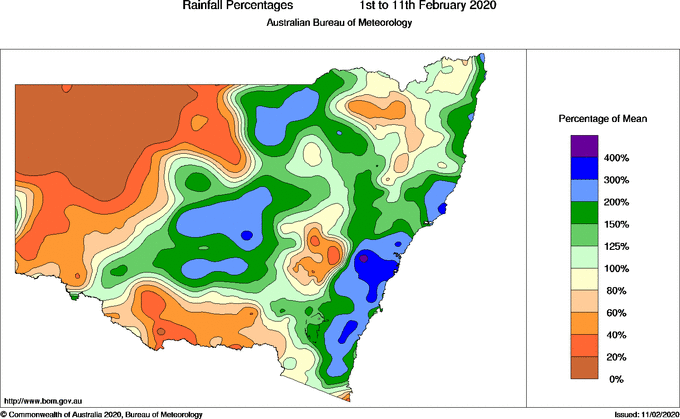Winners and losers after a wet week in NSW
While heavy rain has topped up dams in some parts of NSW this month, the drought still hasn't loosened its grip in many areas.
A stream of moisture-laden winds feeding into a slow-moving upper-level trough produced heavy rain in parts of NSW last week. This week, showers and thunderstorms have affected large parts of the state each day, some of which have been severe and brought additional bursts of heavy rain.
As of 9am on Tuesday this week, parts of eastern NSW and some areas in the states Central West and North West Slopes and Plains had received 100-200 percent of their monthly average rain for February. A few areas in the state's east have already seen more than three times their February averages, only one third of the way through the month.
But while rain has been good in some places, it hasnt fallen everywhere. Running monthly totals are still below 40 percent of the February average in parts of central western and south western NSW, while much of the state's far northwest is still below 20 percent.

Image: Percentage of the average February rainfall (whole month) that had fallen in NSW by 9am on Tuedsay. Source: Bureau of Meteorology
The consequence of this month's uneven rainfall distribution is that some catchments have quickly rebounded from multiple years of declining water storages, while others haven't budged.
In Sydney, where around 400mm of rain fell during four days late last week, water storages have reached their highest level in nearly two years. Further inland, some dams in the northern Murray Darling Basin were still below five percent of capacity at the middle of this week, including Pindari (4%), Keepit (4%) and Burrendong (2%).
Looking ahead, widespread showers and thunderstorms will continue to affect NSW during the remainder of this week. While the rain from some of these storms will be heavy enough to cause localised flash flooding, widespread river flooding is unlikely.
For many areas of NSW, it will take multiple months of above average rain to break the drought that has built up during several drier-than-usual years.